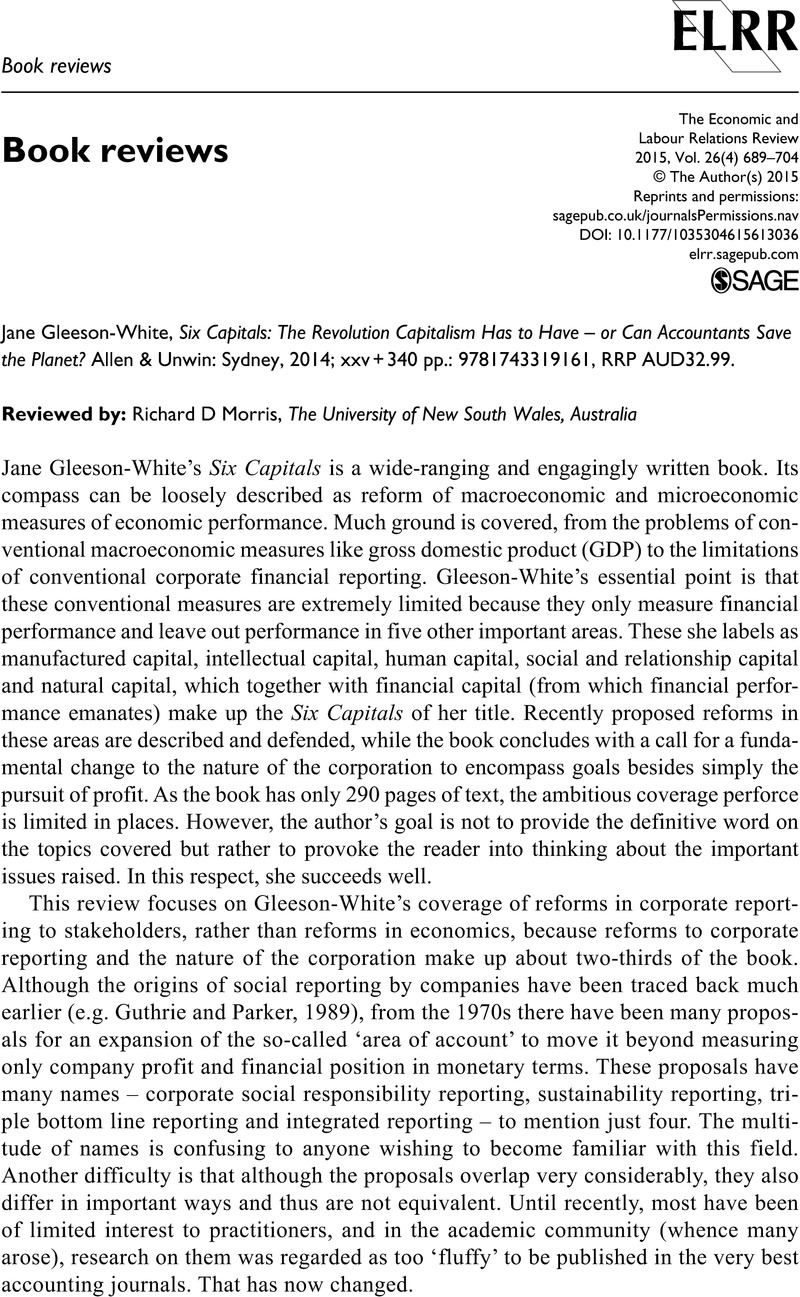No CrossRef data available.
Article contents
Jane Gleeson-White, Six Capitals: The Revolution Capitalism Has to Have – or Can Accountants Save the Planet?Allen & Unwin: Sydney, 2014; xxv + 340 pp.: 9781743319161, RRP AUD32.99.
Review products
Jane Gleeson-White, Six Capitals: The Revolution Capitalism Has to Have – or Can Accountants Save the Planet? Allen & Unwin: Sydney, 2014; xxv + 340 pp.: 9781743319161, RRP AUD32.99.
Published online by Cambridge University Press: 01 January 2023
Abstract
An abstract is not available for this content so a preview has been provided. Please use the Get access link above for information on how to access this content.

- Type
- Book reviews
- Information
- The Economic and Labour Relations Review , Volume 26 , Issue 4: Special Collection: Union Organising and Revitalisation , December 2015 , pp. 689 - 693
- Copyright
- Copyright © The Author(s) 2015
References
Chambers, RJ
(1975) Accounting for inflation (exposure draft). See also Chambers as CoCoA. Available at: http://sydney.edu.au/business/chambers/cocoa (accessed 29 August 2015).Google Scholar
Clarkson, P, Overell, M, Chapple, L
(2011) Environmental reporting and its relation to corporate environmental performance. Abacus 47(1): 27–60.Google Scholar
Deegan, C, Rankin, M
(1996) Do Australian companies report environmental news objectively? An analysis of environmental disclosures prosecuted successfully by the Environmental Protection Authority. Accounting, Auditing and Accountability Journal 9(2): 50–67.Google Scholar
Dhaliwal, D, Li, Z, Tsang, A, et al
. (2011) Voluntary non-financial disclosure and the cost of equity capital: the case of corporate social responsibility reporting. Accounting Review 87(3): 723–759.Google Scholar
Gellein, OS
(1987) Capital maintenance: a neglected notion. The Accounting Historians Journal 14(2): 59–69.Google Scholar
Guthrie, J, Parker, LD
(1989) Corporate social reporting: a rebuttal of legitimacy theory. Accounting and Business Research 19(76): 343–352.CrossRefGoogle Scholar
International Integrated Reporting Council (IIRC) (2013) The International <IR> Framework. Available at: http://integratedreporting.org/wp-content/uploads/2013/12/13-12-08-THE-INTERNATIONAL-IR-FRAMEWORK-2-1.pdf (accessed 30 September 2015).+Framework.+Available+at:+http://integratedreporting.org/wp-content/uploads/2013/12/13-12-08-THE-INTERNATIONAL-IR-FRAMEWORK-2-1.pdf+(accessed+30+September+2015).>Google Scholar
KPMG (2013) The KPMG Survey of Corporate Responsibility Reporting 2013. Available at: https://www.kpmg.com/Global/en/IssuesAndInsights/ArticlesPublications/corporate-responsibility/Documents/corporate-responsibility-reporting-survey-2013-exec-summary.pdf
Google Scholar
Ma, R
(1982) Current cost accounting and physical capital: an Australian perspective. In:
Sterling, RS, Lemke, KW
(eds) Maintenance of Capital: Financial versus Physical. Houston, TX: Scholars Book Co., pp. 195–223.Google Scholar
Morris, RD
(1991) Distributable profit in Britain since 1980: a critical appraisal. Abacus 27(1): 15–31.CrossRefGoogle Scholar


